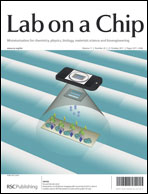A microfluidic in situ analyzer for ATP quantification in ocean environments
Abstract
We have developed and tested a functionally integrated in situ analyzer, the IISA-ATP system, for microbial activity assays based on a quantitative determination of the total (particulate and dissolved) ATP in ocean environments. The IISA-ATP utilizes a PDMS–glass hybrid microfluidic device as its core functional element, which can perform cell lysis and total ATP quantification by a


 Please wait while we load your content...
Please wait while we load your content...